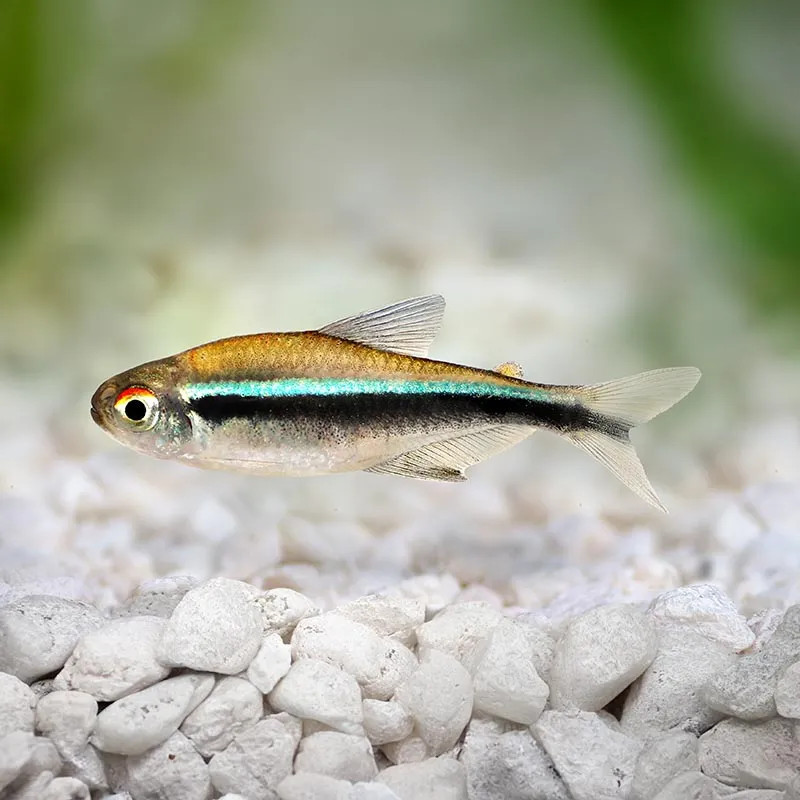Stocks Available
Glowlight Tetra Group
SKU:120688
HEMIGRAMMUS ERYTHROZONUS
1 INCH

Stock Available
Introduction • Common Name: Black Neon Tetra • Natural Habitat: Native to the Paraguay River Basin in South America, specifically found in slow-moving streams and tributaries with dense vegetation. Physical Characteristics • Appearance: The Black Neon Tetra is named for its striking appearance, with a deep, dark stripe running horizontally across its body, contrasted by an iridescent, neon-like stripe above it. This unique coloration sets it apart from the standard Neon Tetra. Its body is more slender and the fins are mostly transparent. • Size: They typically grow up to 1.5 inches (3.8 cm) in length, making them a small, manageable species for community aquariums. • Lifespan: With proper care, the Black Neon Tetra can live up to 5 years in captivity. Habitat Requirements • Tank Size: A minimum tank size of 10 gallons is recommended, though a larger tank is preferable for groups and community setups. • Water Conditions: o Temperature: The ideal range is 72-79°F (22-26°C). o pH: Slightly acidic to neutral, between 5.5 and 7.5. o Water Hardness: Prefers soft to moderately hard water. • Aquascaping: These fish thrive in tanks with plenty of plants, driftwood, and subdued lighting to mimic their natural environment. Floating plants are beneficial as they create dim lighting conditions, which Black Neon Tetras prefer. Diet • Primary Diet: Black Neon Tetras are omnivores and can be fed a mix of high-quality flakes or micro pellets. • Supplemental Feeding: They enjoy live and frozen foods such as brine shrimp, daphnia, and bloodworms, which help enhance their health and coloration. • Feeding Frequency: Feed them small amounts twice a day. Avoid overfeeding to prevent water quality issues. Behavior and Compatibility • Temperament: Black Neon Tetras are peaceful and social fish, making them ideal for community tanks. They should be kept in groups of at least six to exhibit their natural schooling behavior and reduce stress. • Suitable Tank Mates: They coexist well with other small, peaceful fish like other tetras, rasboras, guppies, corydoras, and dwarf gouramis. Avoid pairing them with aggressive or larger species that may see them as food. • Incompatibilities: Avoid housing them with aggressive or large predatory fish that may attack or eat them. Care Level • Difficulty: Black Neon Tetras are relatively easy to care for, making them suitable for both beginners and experienced aquarists. • Maintenance: Regular water changes, at least 20% weekly, are essential to maintain their health. Stable water parameters are also key to preventing stress and disease. Breeding • Reproduction: Black Neon Tetras are egg layers. Breeding can be achieved in a separate breeding tank with soft, slightly acidic water and fine-leaved plants or spawning mops for egg-laying. • Breeding Behavior: Males will court females through displays of color and movement. Females lay eggs, which are fertilized by the males. The eggs are often scattered over plants. • Fry Care: After spawning, adults should be removed from the breeding tank to prevent them from eating the eggs. Fry will hatch in 24-36 hours and can be fed infusoria or liquid fry food once free-swimming. Health and Disease • Common Issues: Like other tetras, Black Neon Tetras are prone to common freshwater fish diseases like ich and fin rot, especially if water quality is poor. Quarantine new fish to prevent introducing diseases to your tank. • Prevention: Maintaining high water quality, avoiding overfeeding, and providing a stress-free environment will minimize the risk of illness. Sustainability and Conservation • Wild Population: Not currently at risk, as they are commonly bred in captivity for the aquarium trade. • Conservation Status: Not listed as endangered, and most specimens sold are bred in aquariums. Conclusion The Black Neon Tetra is a peaceful, beautiful fish that adds elegance to any planted aquarium. Its ease of care, coupled with its striking appearance, makes it a popular choice for community tanks. By providing them with the right conditions and companions, aquarists can enjoy the beauty and charm of this species for years.
Data sheet
16 other products in the same category:
Customers who bought this product also bought: